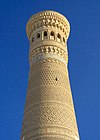Koi Krylgan Kala

Koi Krylgan Kala (Uzbek: Qoʻyqirilgan qalʼa; Russian: Кой-Крылган-Кала) is an archaeological site located outside the village of Taza-Kel'timinar in the Ellikqal'a District (Uzbek: Ellikqalʼa tumani; Russian: Элликкалинский район) in the Republic of Karakalpakstan, an autonomous republic of Uzbekistan. In ancient times, it was sited along a canal in the Oxus delta region.
There is some relationship between Koi Krylgan Kala and Toprak Kala, 30 km to the northwest.[1] It is a temple complex of the Chorasmian Dynasty, an Iranian people who ruled the area of Khwarezm. It was built c. 400 BCE. The Apa-Saka tribe destroyed it c. 200 BCE, but later it was rebuilt into a settlement, which lasted until c. 400 CE.[2] It was discovered in 1938 by Sergey Pavlovitch Tolstov, leader of the Chorasmian Archaeological-Ethnological Expedition. It contained a Mazdian fire temple and was decorated with frescos of wine consumption.
Notes
References
- Yar-Shater, Ehsan (1983). The Cambridge history of Iran. Cambridge University Press. pp. 1488 pages. ISBN 0-521-24693-8.
{{cite book}}: Cite has empty unknown parameter:|coauthors=(help)
- Eduljee, K. E. (2007). "Zoroastrian Heritage". Heritage Institute. Retrieved 27 July 2009.
{{cite web}}: Cite has empty unknown parameter:|coauthors=(help)

